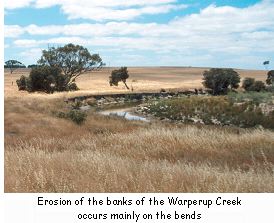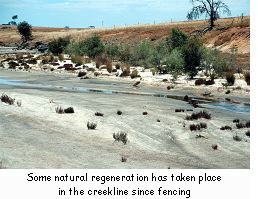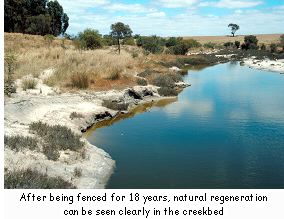 The Site
The Site
Michael Wright has managed the 3200 hectare farm on the Warperup Creek for the past 12 years. It was the original farm in the area and a cottage that was built in 1890 still stands there. The farm is situated 9.5 kilometres southwest of Ongerup on the Ongerup-Gnowangerup Road. Eight kilometres of the Warperup Creek runs through the property before emptying eventually into the Pallinup River to the southwest. The head of the Warperup Creek is some 14 kilometres to the northeast and is fed by numerous tributaries, including the Ongerup and Meenup Creeks. The creek has many exposed granite outcrops along its length and the original vegetation included yate, melaleuca and sheoak woodland.
In 1997 Michael began rehabilitation of the creek using fencing and replanting.
The Problem
Michael was told that in 1955 a flood washed the creek clear of vegetation, and that prior to that people used to swim in the pools along the creek. The stock had access to the creek until 1977 and they had grazed the vegetation until the creekline was bare.
The creek floods about once every four years and Michael has noticed that the bank in a bend in the creek has eroded back about five to six metres in the last 12 years. Bank erosion is also occurring to a lesser degree at other sites along the creek.
 The Solution
The Solution
In an attempt to stabilise the creek and prevent further bank erosion a program of fencing and replanting along the creekline began in 1997. In September 1997 the creek was fenced on both sides leaving a corridor ranging from 50 to 100 metres wide. The corridor was direct seeded and also seedlings were planted in three rows where possible, depending on space for the tractor and Chatfield Planter. No herbicide was used prior to seeding but the creek was baited for rabbits.
Frost killed about 30% of the seedlings in 1997 and rabbits ate many more. Some natural regeneration has taken place since fencing.
Michael is experimenting with a program of seeding native tree species and jam (Acacia acuminata) in a floodplain area between two branches of the Warperup Creek.
In the first year he plants jam then in the following year he plants sandalwood in between the rows of jam. It is still too early to say if this is going to be successful but early signs are encouraging.
 A section of the creek south of the Ongerup-Gnowangerup Road was fenced 18 years ago and natural regeneration can be seen clearly in the creekbed. Species that have regenerated include samphire, melaleucas, acacias, jacksonia and native rushes and sedges. To further enhance the riparian corridor Michael recently planted trees along the fence line. This section now appears to be stable and in time he hopes that the rest of the creek will respond in the same way.
A section of the creek south of the Ongerup-Gnowangerup Road was fenced 18 years ago and natural regeneration can be seen clearly in the creekbed. Species that have regenerated include samphire, melaleucas, acacias, jacksonia and native rushes and sedges. To further enhance the riparian corridor Michael recently planted trees along the fence line. This section now appears to be stable and in time he hopes that the rest of the creek will respond in the same way.
The Outcomes and Observations
As well as stabilising the creek Michael has found that fencing has made it easier to manage the sheep. In time he believes that there will be an improvement in the aesthetics of the farm and a better environment overall.
Michael has learned from this project and he believes that at least three rows are needed to make an effective windbreak. He also found that gates are needed in the fence for fire access in emergencies. Rabbits have been a major problem and Michael would always carry out rabbit control before any future seeding or planting. He has actually decided not to plant in some areas because of rabbits. He has found that direct seeding has been the most successful, even though no pre-seeding weed control was carried out, and believes that direct seeding is able to compete adequately with the weeds.
Warperup Creek Catchment Statistics
| Type of stream: | Ephemeral creek with ephemeral pools | |
| Rainfall range: | 375-400 mm./year | |
| Water quality: | Saline | |
| Catchment disturbances: | Cropping, stock grazing |
Map Reference: 1: 50 000 2529-I 2530-II





